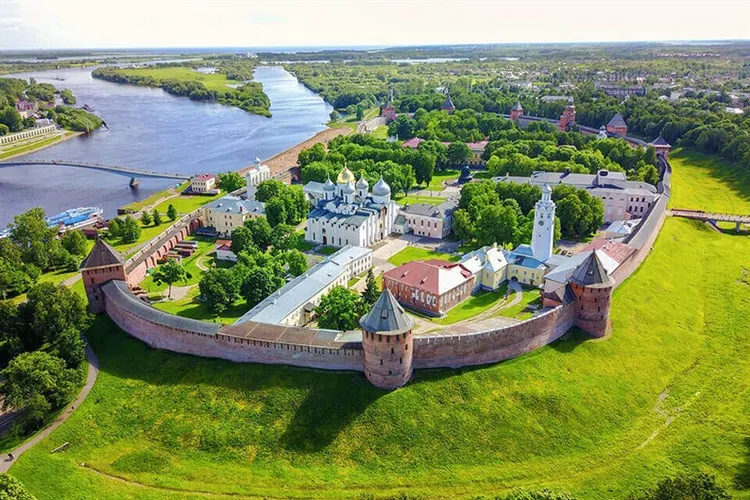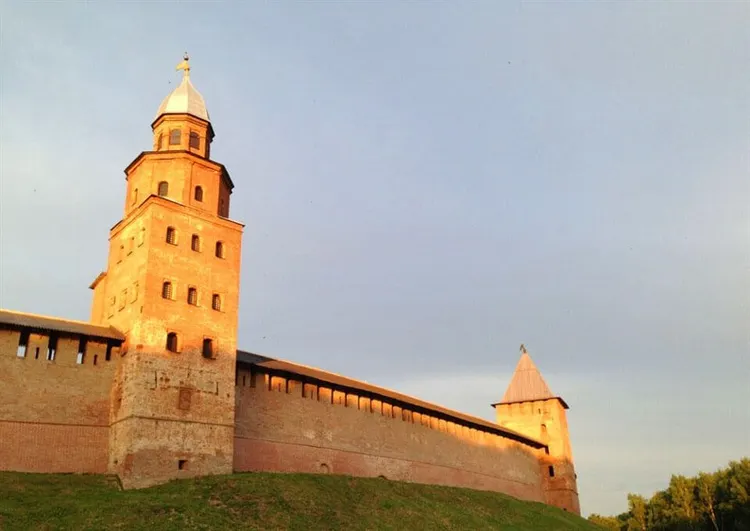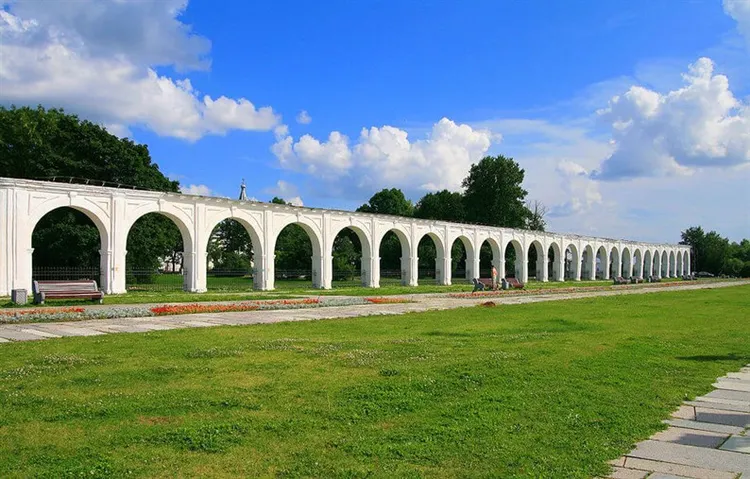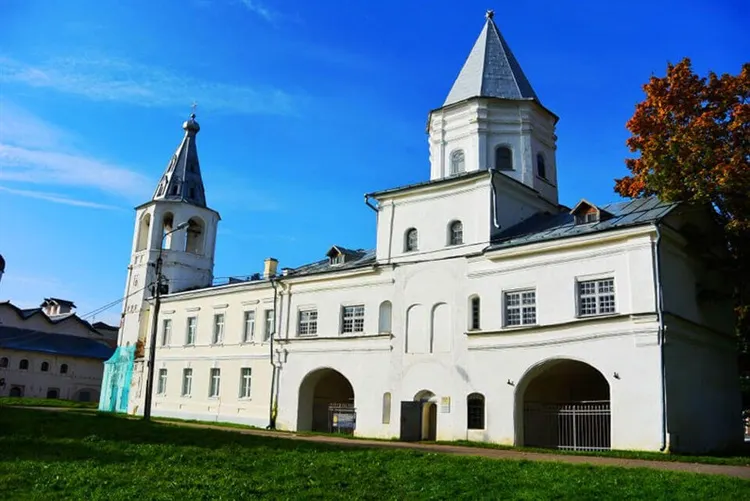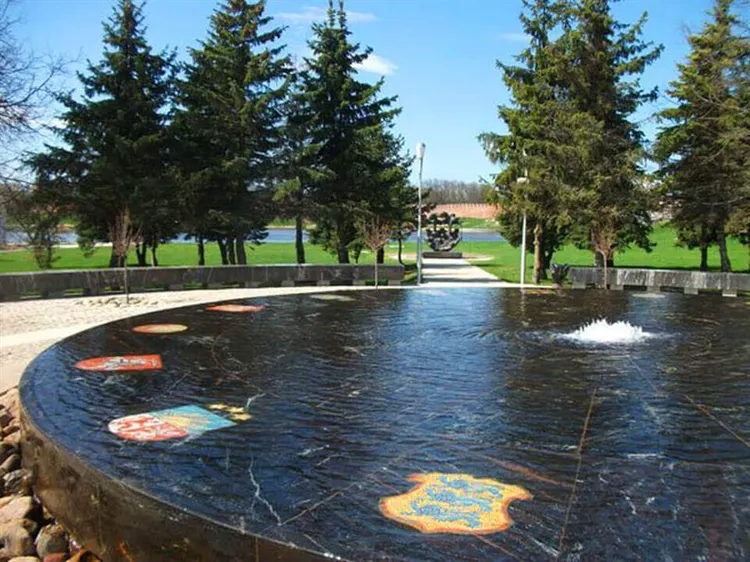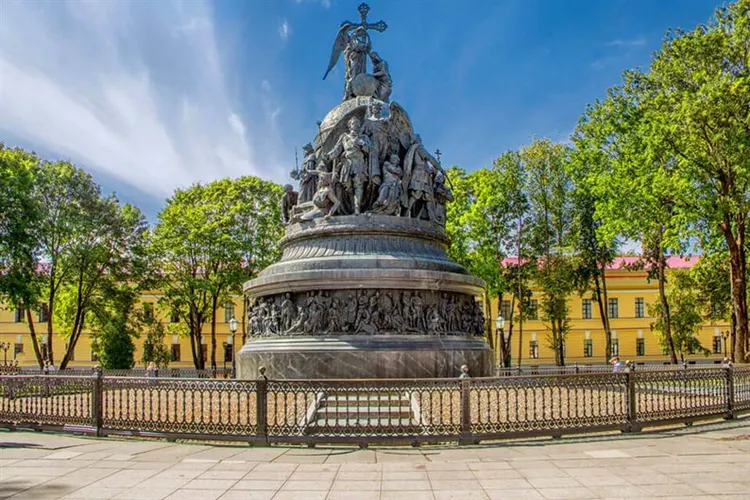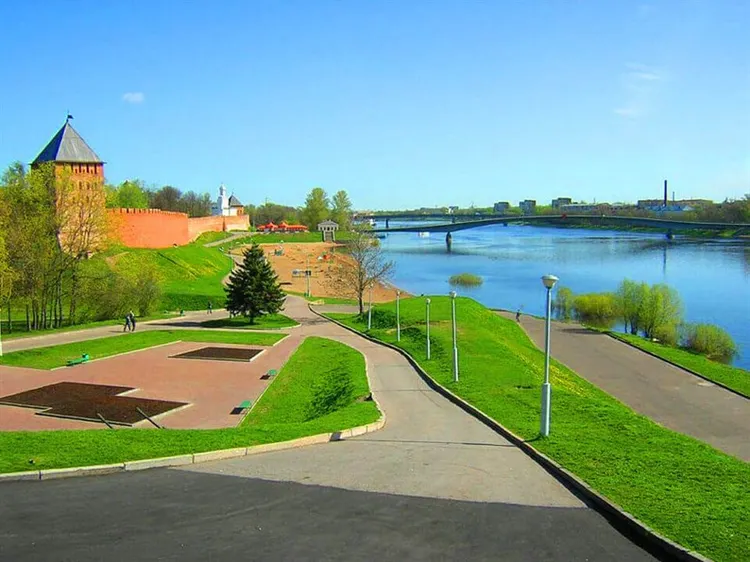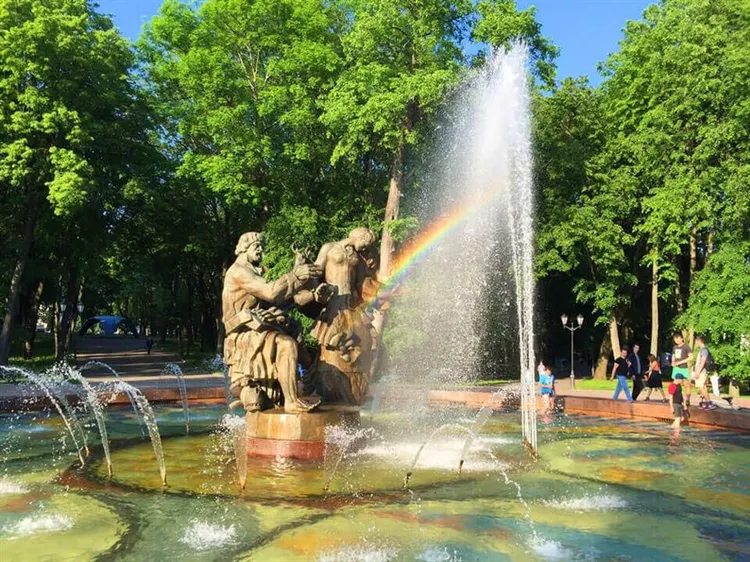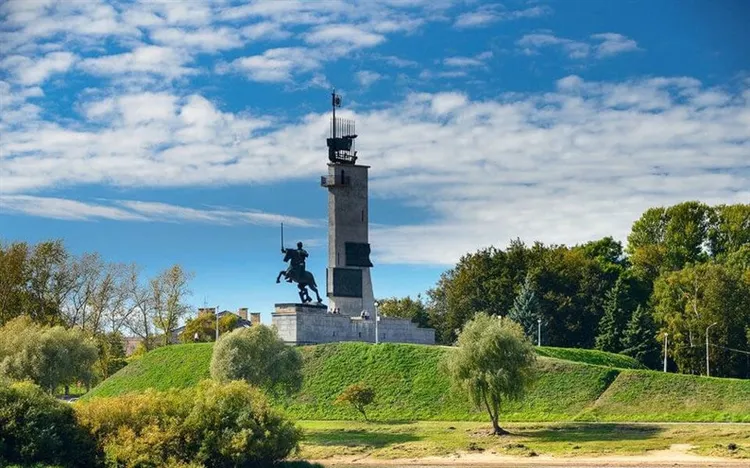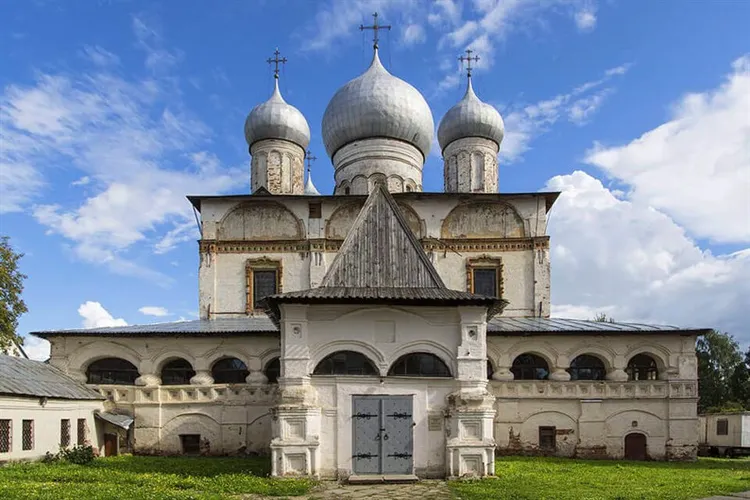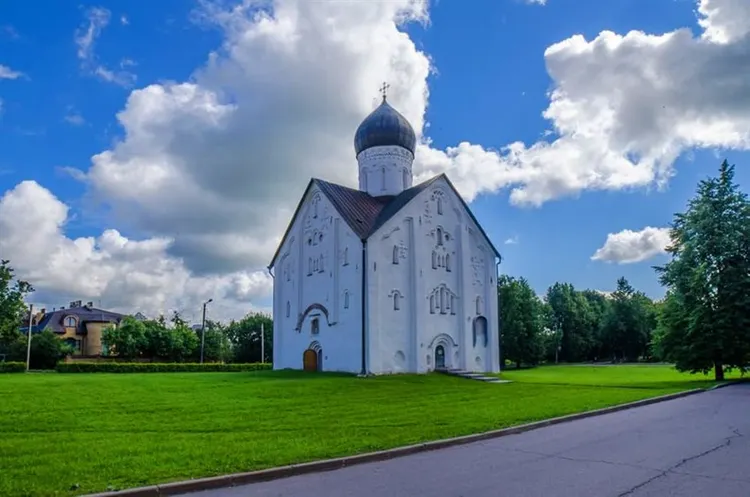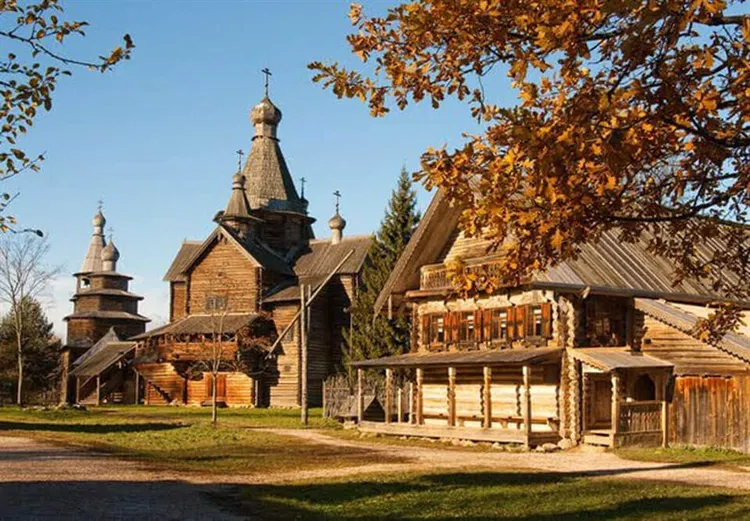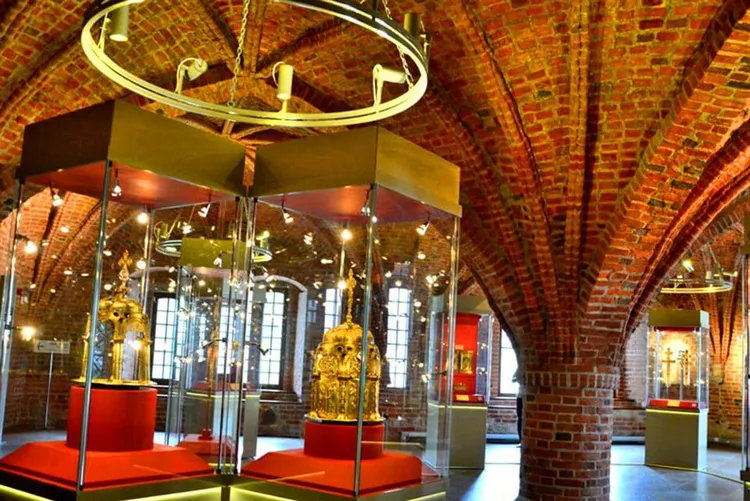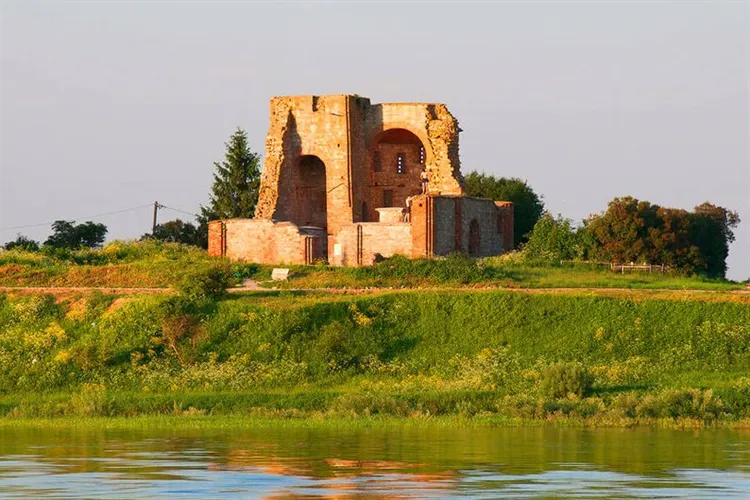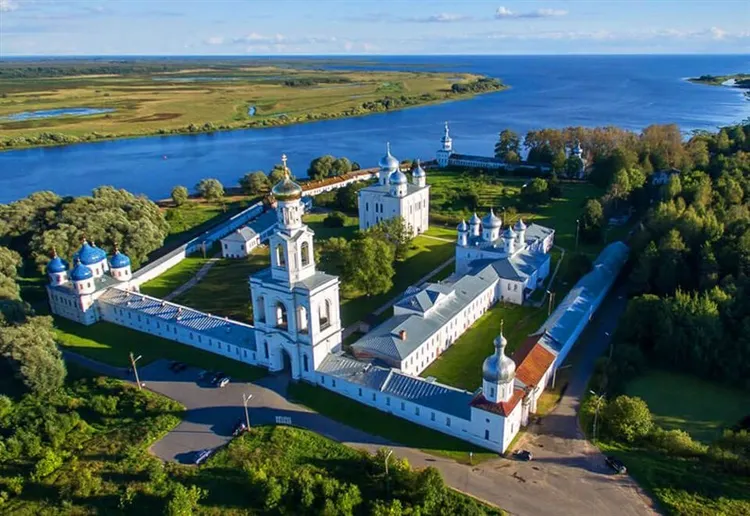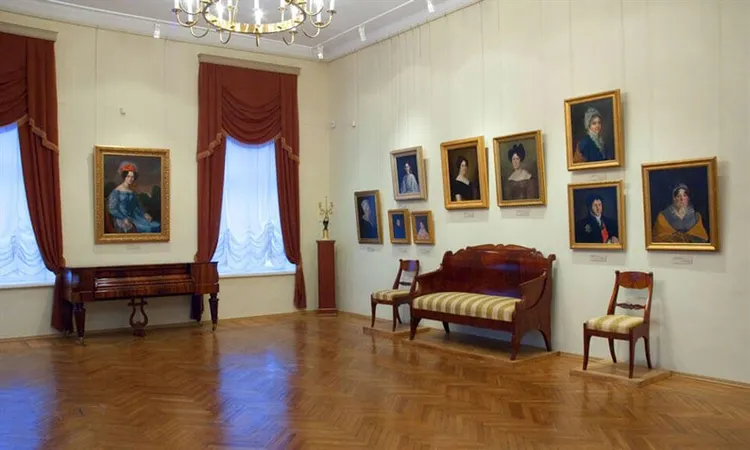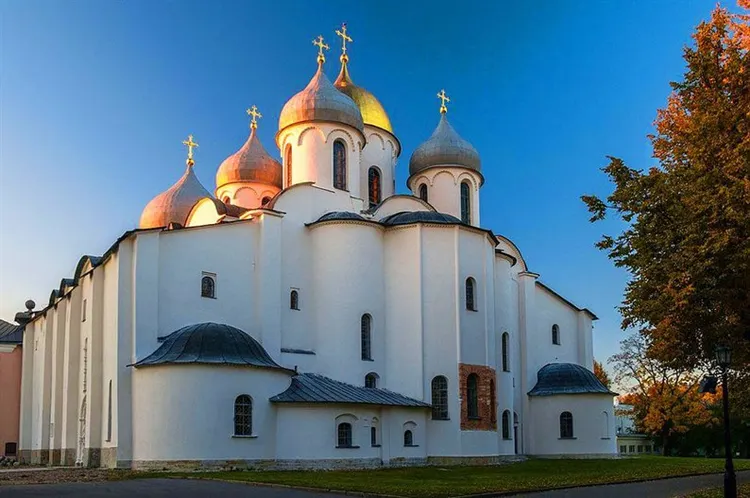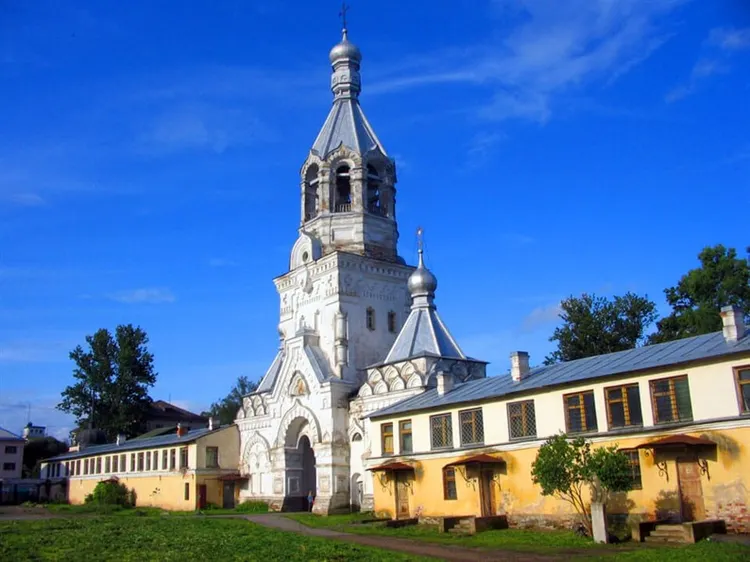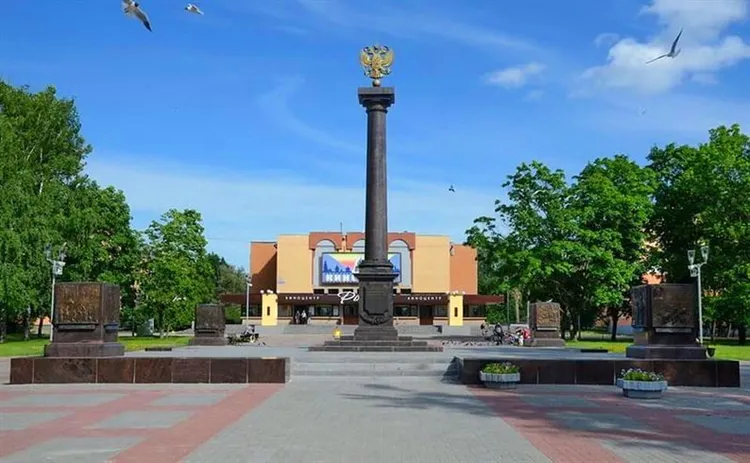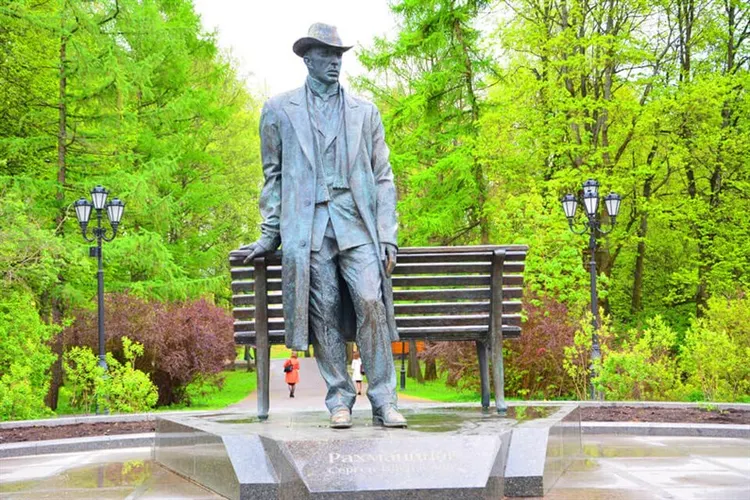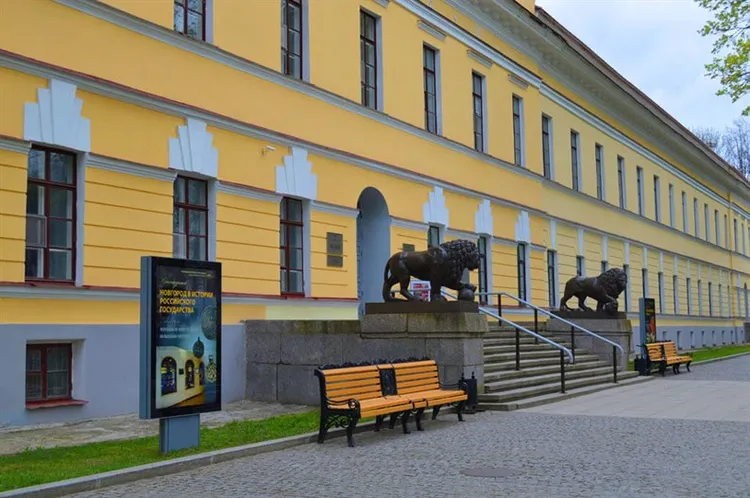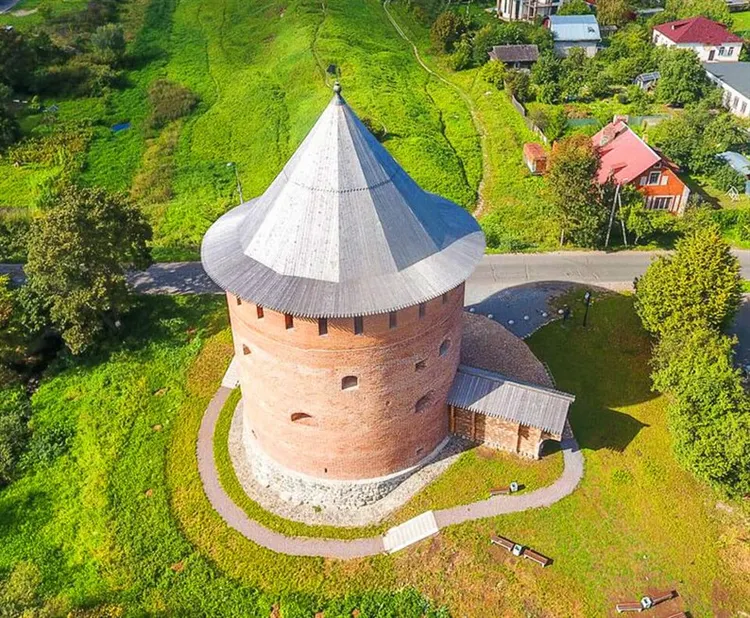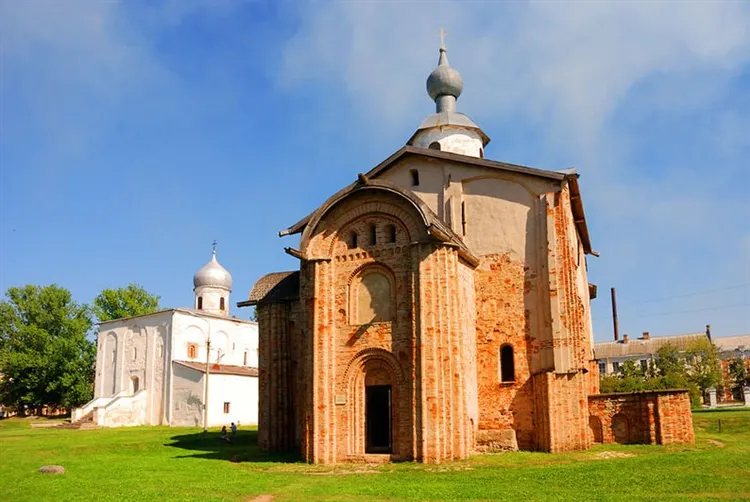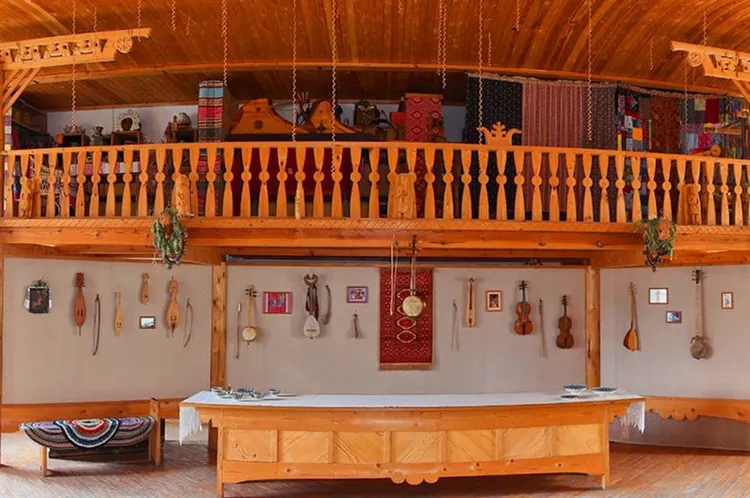Sights of Veliky Novgorod – 25 most interesting places
For more than 13 centuries, in the northwestern side of Russia, near the source of the Volkhov River, there has been ancient Veliky Novgorod, which has become a unique city-museum of Ancient Russia during its existence. The official date of its foundation is 859. Prince Rurik, who became the founder of the Russian royal dynasty, was invited here in 862 by local tribes. In 1136, the city became the birthplace of the Novgorod Republic, when for the first time the townspeople were gathered by the blows of the bell for a national assembly.
Novgorod detinets
The construction of the Novgorod citadel (Kremlin) as a military-defensive fortress dates back to the 11th century. In 1116 the wooden detinets was rebuilt into a stone one and completed over the following centuries, becoming the religious and administrative center of the city in the 15th-17th centuries. The Kremlin, built for the first time in Russia from red brick, is surrounded by walls 8 to 15 meters high and up to 6.5 meters thick for almost 1.5 km.
Of the 12 Kremlin towers that were in the 15th century, tourists will be able to look at the multi-tiered architecture of the remaining 9 tower buildings. Tours with visits to the towers are held inside the Kremlin walls, culminating in a panoramic view of the Kremlin and the city from a height of 40 meters. On the territory of the citadel there are preserved: the oldest temple in Russia – St. Sophia Cathedral (1045-1050), the Vladychnaya Chamber (1433) and other monuments of the XV-XIX centuries. The Kremlin Ensemble, as an open-air museum, is listed as a UNESCO World Heritage Site.
Kokui Tower
The watchtower Kokui stands out among the other towers in the Kremlin wall with its original form, rising 41 m above the surroundings. It has been the main observation post of the Voivodship Court since the 17th century, after the rebuilding of a deaf rolling tower, the upper tier of which served to install guns. Today, a three-story rectangular building with two octagonal tiers on top appears before our eyes.
Kokuy is crowned by a 10-meter white iron tent, completed with the coat of arms of the Novgorod state. The two lower floors served as a wine cellar and state chambers, from the third floor there were exits to the fortress wall. From the observation deck of the tower, a stunning panorama opens up overlooking the complex of the St. George's Monastery and the Knyazhaya, Palace and Spasskaya towers, guessed by the 5-ruble bill. The observation deck on Kokuya is equipped with two telescopes that increase the view of the observed objects by 60 times.
Arcade of Gostiny Dvor
The arcade of Gostiny Dvor is one of the oldest sights. It represents the rest of Gostiny Dvor in the second half of the 17th century. In the 11th century, Yaroslav's Courtyard and Torg were located on this historical site, from the 12th to the 15th centuries there was the Torgovaya Square, where the veche was also held. After a fire in 1606, the construction of Gostiny Dvor began on this site, which lasted for the 17th-18th centuries.
The complex was built in the form of a closed square with a gallery, shopping arcade buildings and an arcade that served as a decorative frame for its facade. Outwardly, the structure of the chain of snow-white arches resembles ancient Roman aqueducts. The grace of the fence is created by arched openings, separated by square columns and relief pilasters along the top. Architecturally, the arcade differs significantly from the wall and towers of Detinets, located opposite, standing out from the general ensemble of the ancient city.
Gate tower of Gostiny Dvor
The structure of the Gate Tower or Gridnitsa, which had a defensive and commercial purpose in the 17th century, has been preserved in the Gostiny Dvor complex. The tower also served as an eastern passage inside the Gostiny Dvor. The architecture of the gate tower appears in the form of an octagon erected on a quadrangular base. On both sides in the lower tiers, the tower building is cut through by two passage arches. The octagon ends with a tent covering topped with a mace.
Today, in the Gate Tower, on three tiers, there is a museum with unique exhibitions of samples of Christian antiquities and artistic metal of the 11th-19th centuries. The highlight of the Novgorod collection were 312 objects of religious worship and utensils, artistically made of non-ferrous metals, items of the 17th-19th centuries with biblical scenes and images of saints, decorated with multi-colored colored enamel. The tower is equipped with an observation deck that opens up a majestic panorama of the ancient city.
Hanseatic fountain
At the Yaroslav's Court, guests of ancient Novgorod like to gather at the Hanseatic fountain, specially built in June 2009 for a significant event – the opening of the International Cultural and Economic Forum “XXIX Hanseatic Days of Modern Times”. In the field of fountain complexes, the fountain-symbol is considered a real exclusive. Its shape is a granite circle, personifying a round negotiating table.
Along the perimeter of the water surface with water spouting in the center, the images of the coats of arms of 16 countries – participants in the modern Hanseatic League, decorated with multi-colored mosaics, attract attention. With the advent of the fountain, a tradition was born to throw a coin into it, testing the local legend that “Volkhovskaya water will wash 1000 rubles” for a ruble thrown into its water and enrich it by 1000 rubles. Every summer, twice a month, a theatrical spectacle of the extraction of coins is held at the fountain, based on the stories of local legends and legends.
Monument “Millennium of Russia”
On the ancient square of Novgorod Detinets, the monument “Millennium of Russia”, erected in 1862 to mark the 1000th anniversary of the Russian state, impresses with its monumentality. A giant orb symbolizing the attribute of autocracy “the Monomakh's cap” rises to 15.7 m on a granite pedestal – a nine-meter bell. The composition of the monument consists of three levels, on which 128 figures are placed, representing the chronicle of Russia in their faces.
Starting the review from the upper level, you are amazed at the figure of a woman crowning the monument, kneeling before an angel with a cross – a symbol of Russia. On the middle level there are 6 groups of sculptures reflecting the historical path of the state, starting from the arrival of the Varangians in Novgorod in 862 and ending with the creation of the Russian Empire. The lower level is made in the form of a frieze with 109 figures of statesmen, enlighteners, famous generals and heroes, writers and artists placed on it.
Kremlin park
The Kremlin park embraces the territory of Novgorod Detinets from three sides, adjoining from the inside to the defensive moat, which stretches along the Kremlin wall. The park was founded on the territory of the Small Earthen City in 1819, calling it the Summer Garden. Today, in the Kremlin Park, which has become a popular recreation area for citizens and tourists, there are many cultural and historical sites that deserve attention: a monument to the composer Sergei Rachmaninoff, the Sadko Fountain, the foundations of 8 ancient churches.
Catherine's Hill is crowned by the Victory Monument, to which a picturesque alley leads. You can spend fascinating leisure time here by watching a concert on the summer stage, visiting the town of souvenirs and the chess house, visiting the Red Hut, driving at the karting track and relaxing in a cafe. Walking along the pedestrian alley, laid along the banks of the Volkhov River, along the line of the former moat, you enjoy the beauty and grandeur of the Kremlin architectural ensemble.
Fountain “Sadko and Princess Volkhova”
The fountain “Sadko and Princess Volkhova”, which has become the decoration of the Kremlin Park, is a favorite resting place for the townspeople. It was built in 1978 on the site of an old fountain with a bust of Stalin. After restoration in 2009, on the occasion of the 1150th anniversary of Veliky Novgorod, Sadko was recognized as the main city fountain. Its center is a sculptural composition with the hero of Russian epics Sadko and the princess Volkhova, framed by a round bowl lined with granite and decorated with mosaic patterns.
The sculptor subtly conveyed the content of the legend in which Sadko plays the harp on the seabed at the whim of the sea king. To the right of the harper, all in attention is the girl – the sea princess Volkhova, who became the savior of the musician. The predominance of the theme of water is conveyed in the flowing clothes of Sadko and the princess, in the torn strings of the harp, reminiscent of sea waves. The amazing view of the Volkhva River and Novgorod Detinets enhances the impression of the fountain.
Pedestrian bridge
From the very foundation, Veliky Novgorod was located on two banks of the Volkhov River: Detinets was historically located on one bank, and the Trade Side was on the other. The connection of the two banks with a permanent bridge already in the first half of the 12th century became a vital necessity. It was built in 1133, connecting the banks in the area of the Kremlin and Yaroslav's Court. The medieval image of the bridge was found on a Swedish engraving of the 17th century.
Over the course of a century, it was repeatedly rebuilt, changing the design. At the beginning of the last century, the bridge was rebuilt as a five-span iron structure mounted on 7 pillars. So it stood until 1944, when it was destroyed by the Nazis. A modern curved girder bridge 250 m long of three spans with arched lines of the lower belt was opened in 1987. It withstands up to 8 thousand pedestrians at the same time and opens up amazing landscapes of the historic city center, divided by the river.
Victory Monument
The complex of the Victory Monument in honor of the Soviet soldiers who won the Great Patriotic War rises on Catherine's Hill in the Kremlin Park. On a high pedestal, a bronze horse with a rider, personifying a Soviet soldier, reared up. The right hand of a warrior with a raised bronze sword calls for battle. The left hand, extended forward with an open palm down, points to a mangled swastika under the horse's belly, symbolizing defeated fascism.
Impressive is the scale of the monument with a height of 8m and a weight of a horse with a rider of 27 tons. In the background of the composition is a monumental building of a brick tower, completed with a boat with ancient military attributes around the perimeter. Together with the boat, the height of the tower was 34.5 m. The tower walls impress with four bas-reliefs depicting battles for the liberation of the city and turning points in the war. You can climb to the top of the tower to the balcony by an internal spiral staircase.
Cathedral of the Sign
The history of the Znamensky Cathedral, which was built near the Church of the Transfiguration of the Savior specifically for the storage of the Novgorod shrine of the icon of the Mother of God of the Sign, goes back to 1354. At the end of the 17th century, a new cathedral was erected in the place of the dilapidated church in the style of Moscow church architecture. The townspeople saw a five-domed two-story temple with arched galleries, porches, porches, facades and interiors decorated with colorful frescoes and colorful decor. In this form, he appears now.
After the reconstruction carried out in the middle of the last century, the restorers managed to uncover unique original frescoes made at the beginning of the 18th century. Particularly impressive is the monumentality of the Last Judgment composition, where Tsar Peter I is guessed in one of the depicted characters. Today, the cathedral is in the status of a museum. His monumental painting can be viewed on Monday-Tuesday, Thursday-Sunday from 10.00 to 17.00
Church of the Transfiguration on Ilyina Street
The Church of the Transfiguration of the Savior on Ilyina Street is an outstanding monument of Novgorod architecture of the 14th century, stunning in its monumentality. The four-pillar square temple with one apse and one dome delights with the richness and sophistication of the decoration of the facades, the shape of the windows and their framing. The walls, drum and apse of the Church of the Savior are loaded with traditional Novgorod decor details, which makes you want to look inside as soon as possible.
In the interior of the temple, the frescoes painted by the famous Byzantine icon painter Theophanes the Greek on the church vaults, dome and drum are amazing. On the domed medallion, an image of Jesus Christ, surrounded by six-winged angels, is skillfully executed. The drum amazes with the expressiveness of the faces of the forefathers and prophets. From above, Adam, Abel, Noah, Melchizedek, Elijah the Prophet, John the Baptist look like they are alive. You can see the divine creations of the master of the brush from Wednesday to Sunday from 10.00-17.00, Monday-Tuesday – days off.
Vitoslavlicy
Near the Yuriev Monastery between Lake Myachino and the Volkhov River, on the site of the ancient village of Vitoslavlitsy, the Museum of Folk Wooden Architecture was created. On its territory, 34 monuments of wooden architecture have been collected, located on several streets. The churchyard, recognized as the center of the village, became the heart of Vitoslavlitsy. It is represented by three churches brought from different regions of the region. You can learn about the life and lifestyle of the estates by visiting the themed huts of the villagers.
The creators of the museum recreated fragments of real peasant estates with barns and forges, baths, carts, sledges, boats, gardens and wells. The Household Yard exposition is impressive with stables, hay sheds, carriage sheds, horses, goats and other domestic animals. Every year the museum hosts folklore festivals, exhibitions and master classes of crafts, the international festival of bell ringing. Vitoslavlitsa can be reached by bus: No. 7 and 7A from the station square.
Sovereign Chamber
The medieval architectural complex of the Vladychnaya (Faceted) Chamber is a unique monument of Russian architecture of the 15th century, made in the Gothic style. The name “Faceted” building is due to the Gothic ribs – the edges that decorate the vaults of the chamber, where the Novgorod saints lived. The main object of the tour was the cell of Archbishop John with walls decorated with frescoes of the 15th century and murals of the early 19th century.
In the three rooms of the chamber, connected by enfilades, many exhibits of a religious nature and relics are exhibited, including the famous icon of Our Lady of the Sign. The hall with Gothic vaults on the second floor is the location of the precious exposition “Jewelry Art of the 5th – 17th Centuries” with items from Byzantium, Ancient Russia and Western Europe: cameos, crosses, caskets, rings made of gold and ivory. You can visit the Vladychnaya Chamber Tuesday-Sunday from 10.00 to 18.00.
Rurik settlement
Rurik settlement is an ancient Viking settlement at the source of the Volkhov River. Back in 862, it became the residence of Prince Rurik, invited by the Ilmen tribes to rule. The settlement is an archaeological monument of the 9th century. During its excavations, the remains of an ancient fortress and residential buildings of the 8th-9th centuries were discovered. The settlement remained the residence of the princes until the accession to the throne of Ivan the Terrible. The temple of the Annunciation of the Most Holy Theotokos, which remained on the site, dates back to the 14th century. It was built on the site of an old church built in 1103 and stood for over 600 years until it was destroyed by the Nazis.
The preserved ruins of the temple are adapted for use today and serve as a year-round museum site open to the public. The temple is open in April from 11.00 to 17.00, from May to October from 12.00 to 19.00, from November 1 to March 31 from 11.00 to 14.00, days off – Thursday-Friday. You can get to Gorodishche from the bus station by bus number 186 to the Spas-Nereditsy stop.
Yuriev Monastery
Yuriev Monastery, founded in the 12th century by the Grand Duke of Kiev Yaroslav, is located in a picturesque place near Lake Ilmen. In the grandiose monastic complex of historical value are:
The ancient white-stone Cathedral of St. George, which serves as the center of the monastery, impresses with its monumental three-domed composition, stretched up to 32 m. In the church interior, the richness of the choirs, the iconostasis and frescoes of the middle of the 12th century on the window slopes and at the top of the stair tower are amazing. The monastery is open to everyone. You can get to it by buses No. 7, 7A from the station.
Art Museum
Since 2001, under the roof of the historic building of the Nobility Assembly, there has been a museum of fine arts. Its permanent exhibition features more than 650 paintings, drawings, sculptures and miniatures – masterpieces of Russian art of the 17th-20th centuries, confiscated from noble estates in the 20-30s of the last century. Part of the collection was supplemented by the Russian Museum Fund. Visitors can enjoy the paintings of outstanding domestic painters: K. Bryullov, I. Aivazovsky, I. Repin, I. Kramskoy, I. Levitan, V. Serov, A. Kuindzhi and others.
Here are sculptures by M. Vrubel and M. Antakolsky. The works are displayed in 7 halls on the 2nd floor and 2 halls on the 3rd floor dedicated to the art of the 20th century. Represents the historical and cultural value of the majolica in the center of the hall, made by Mikhail Vrubel. The museum is located on Sofia Square and is open to visitors daily from 10.00 to 18.00, except Monday and the first Thursday of the month.
Saint Sophie Cathedral
The history of one of the main monuments of ancient Russian architecture – St. Sophia Cathedral and its belfry, which has no analogues in Russia, goes back to 1045. The stone temple was erected by Kiev and Byzantine architects under Yaroslav the Wise and his son Vladimir as the main cathedral of the city. The architecture of the cathedral is expressed by a structure in the form of a cross with five domes: the main one is gilded and silver on the sides. The temple is notable for three apses: five-sided – in the center and round on the sides.
On three sides the cathedral is surrounded by galleries. Of the ancient external murals, images of Saints Constantine and Helena on the porch, made on dry plaster, have been preserved. According to the fragments of the three-meter images of the prophets on the central drum left from the 11th century, one can get an idea of the past frescoes of the cathedral. Two altar icons of the 11th century in the iconostasis of the 14th-16th centuries and the miraculous icon “The Sign”, painted in 1170, have also been preserved. The cathedral is open daily from 8.00 to 20.00
Tithe Monastery
On Desyatinnaya Street, the colorful white stone structure of the bell tower, which serves as the entrance to the former Tithes Convent, is striking. According to the chronicle, the date of foundation of the monastery was 998. Other references date back to 1170 in connection with the siege of Novgorod by the army of the Suzdal prince Andrey Bogolyubsky, who was protected from it by the icon “The Sign”, exhibited near the Tithes Monastery of the Roundabout City. Most of the historical buildings of the monastery have been preserved here, in which cells, a refectory, and a kvass were located.
Unfortunately, the temples of John the Baptist (15th century) and the Nativity of the Virgin (1397, rebuilt in the 1670s, as evidenced by the remaining ruins of the temple of the 17th century, did not survive. Art workshops and an exhibition hall were located in the monastery premises. The stone bell tower, built in style of ancient Russian Moscow architecture, has come down to us in the form that it acquired after the restructuring of 1903.
Monument-stele “City of Military Glory”
The stele “City of Military Glory” was opened on the eve of the 65th anniversary of the Victory on the square of the Square of Military Glory. The monument looks like a 10-meter column on a granite pedestal topped with the coat of arms of Russia. On the sides of the central monument are 4 mini-steles with four periods of Russian military glory. The stele of Old Russian history is represented by 4 narrative bas-reliefs of the campaigns of Yaroslav the Wise, the repulsion by the townspeople of the Vladimir-Suzdal army, the defense of the city and Torzhok from the Tatar invasion, and the victory of Alexander Nevsky on Lake Peipsi.
The second stele depicts: the Moscow campaign of the militia, the defense of Novgorod from the Swedes, the events of the Northern War with Peter I and the Battle of Poltava. The imperial period is represented by the victories of A.V. Suvorov, the battle in the war of 1812, the heroism of the Novgorodians in the Russian-Turkish, Japanese and First World Wars. The Soviet period shows the exploits in the Great Patriotic War and in local military conflicts.
Monument to Sergei Rachmaninoff
Veliky Novgorod is the birthplace of the greatest Russian composer Sergei Rachmaninov, where he lived and created his famous musical works before emigrating to the United States. The monument to the composer, made by the famous Russian sculptor A. Rukavishnikov, was installed in June 2009. A low pedestal with a monument was installed on a round base with four ladders, which made the sculptural composition an organic part of the square.
The originality of the monument is expressed in the figure of a musician leaning against a park bench with his back, leaning on its back with his right hand. The composer's gaze is directed at the new city, behind it is the picturesque landscape of the Kremlin park and the alley leading to the fortress wall of the ancient Kremlin. The ease of posture in the monument made it attractive from any vantage point. Installed around the bronze composer, real park benches are perfectly combined with the sculpture's bronze bench.
Novgorod Museum-Reserve
The Novgorod Museum-Reserve is more than 150 years old. Being the most significant collection of rare monuments of architecture and monumental painting of the 11th-17th centuries in Russia, it, with its numerous branches, is listed as a UNESCO protected site. As part of the museum-reserve, there are several exhibition halls with unique expositions, many historical and cultural monuments of Veliky Novgorod and the region are preserved.
The museum arranges exhibitions with exhibits of ancient Russian carved wood, Russian icons of the 11th-19th centuries, the history of the Novgorod land from ancient times, and others. Tourists are offered a wide range of excursions with visits to the architectural monuments of the city, the Vitoslavlitsy Museum of Wooden Folk Architecture, calendar folklore and ethnographic holidays and art exhibitions from the fund of Russian museums, master classes in folk crafts. The administrative building of the museum is located in the Kremlin, building 11.
Alekseevskaya tower
The Alekseevskaya (White) Tower is part of the outer ring of fortifications of the Roundabout City and the Small Earthen City and a unique preserved monument of medieval fortification. The tower rises at the junction of the 11-meter defensive wall that surrounded Okolny and Maly Zemlyanoy cities and served to protect the Kremlin from enemies. The White Tower is the only surviving defensive structure of the outer border, which has come down from the 16th-17th centuries.
The tower, together with the fortifications, was erected during the Livonian War by order of Tsar Ivan the Terrible for cannon defense of the approaches to the city. The architecture of the building is round in shape, with an outer diameter of 17m and an inner diameter of up to 8.4m, which indicates a large thickness of the walls. The height of the tower, built on a powerful foundation lined with granite stones protruding by 0.5 m, was 15 m. An exposition dedicated to the history of the Novgorod fortress and its garrison is being created inside the White Tower.
Church of Paraskeva Pyatnitsa at the Market
The Temple of Paraskeva Pyatnitsa at the Market in Novgorod is a landmark in the architectural complex of the Yaroslav's Court. The temple dedicated to the great martyr Paraskeva Pyatnitsa, the intercessor of the merchants, was erected at the expense of merchants who traded “beyond the seas” in 1156. At the beginning of the 13th century, the church was rebuilt in stone. The church got its current appearance after the restoration of the second half of the last century.
It appears as a light single-domed cross-domed, four-column building with three naves and one apse. From the old temple, the northern limit has been preserved, and the remaining fragments of the two ancient limits have been completed by restorers. In the church, you can see masonry sections of the 13th-16th centuries, freed from plaster. The dome of the 18th century and the pilasters on the facade remained unchanged. The interior is distinguished by openwork decoration and comfort. Now the temple of Paraskeva Pyatnitsa is a museum object open to visitors: Thursday-Monday: 11.00 -18.00.
Center for Musical Antiquities V.I. Povetkin
Tourists interested in music should see the unique exhibits of the Center for Musical Antiquities, located on Ilyina Street. The museum center was created by the artist-restorer Vladimir Povetkin with the aim of restoring the form and sound of musical instruments used in the 10th-15th centuries. In addition to replenishing the collection, studying the history of ancient instruments, the center holds lecture-concerts with playing the harp, whistles, snots and other folk instruments.
Under their accompaniment, choirs and ensembles perform with folk and ritual songs, tunes. The center will teach you how to tune the harp, sewing folk clothes and many folk crafts. Thematic excursions are held here: “The Sounding World of Ancient Novgorod” – on Saturdays and Sundays and “The World of the Center for Musical Antiquities” – from Tuesday to Friday. You can visit the unique realm of ancient Russian music from Tuesday to Sunday from 14.00 to 15.30.
